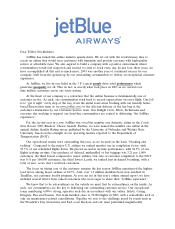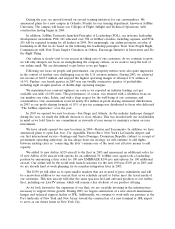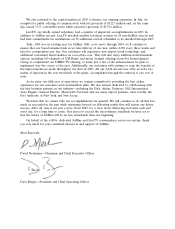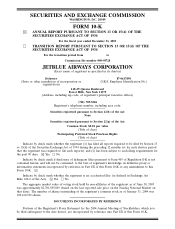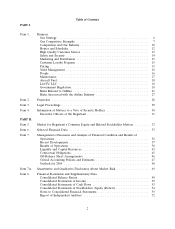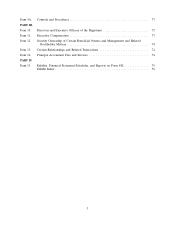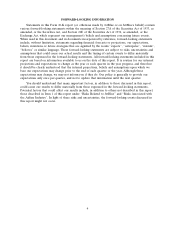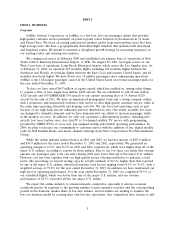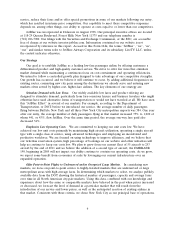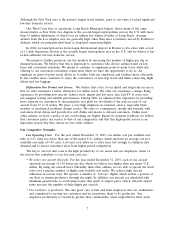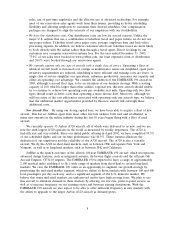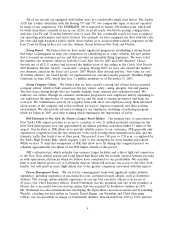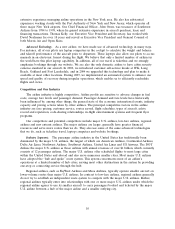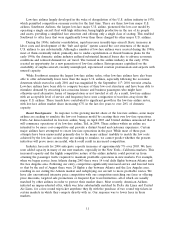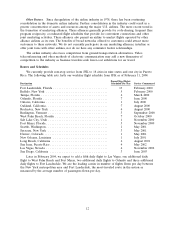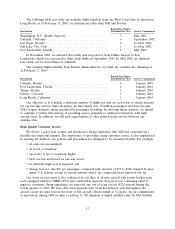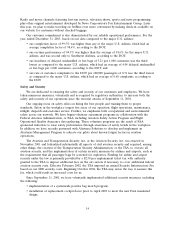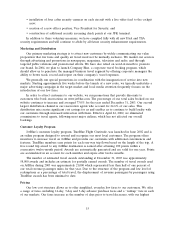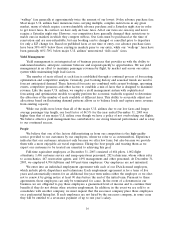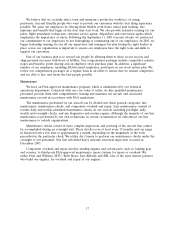JetBlue Airlines 2003 Annual Report Download - page 10
Download and view the complete annual report
Please find page 10 of the 2003 JetBlue Airlines annual report below. You can navigate through the pages in the report by either clicking on the pages listed below, or by using the keyword search tool below to find specific information within the annual report.Although the New York area is the nation’s largest travel market, prior to our entry it lacked significant
low-fare domestic service.
Our West Coast base of operations, Long Beach Municipal Airport, shares many of the same
characteristics as New York. Los Angeles is the second-largest metropolitan area in the U.S. with more
than 16 million inhabitants, of which over six million live within 20 miles of Long Beach. Average
airfares from the Los Angeles area are generally high, other than fares to markets served by Southwest
Airlines, which are primarily short-haul or long-haul connecting flights.
In 2004, we launched service from Logan International Airport in Boston to five cities with a total
of 11 daily departures. Boston is the seventh largest metropolitan area in the U.S. and we believe it has
lacked sufficient low-fare domestic service.
We intend to further penetrate our key markets by increasing the number of flights per day as
demand warrants. We believe that this is important to customers who choose airlines based on low
fares and convenient schedules. We intend to continue to emphasize point-to-point travel while also
offering to our customers convenient connections where we have the opportunity to do so. An
emphasis on point-to-point travel allows us to utilize both our employees and facilities more efficiently.
It also enables more customers to enjoy the convenience of non-stop travel and limits connecting flight
delays and lost baggage.
Differentiate Our Product and Service. We believe that a key to our initial and long-term success is
that we offer customers a better alternative for airline travel. We offer our customers a unique flying
experience by providing new aircraft, leather seats, simple and low fares, free LiveTV at every seat,
pre-assigned seating and reliable performance. During 2003, we enhanced this experience by providing
more legroom for customers by increasing the seat pitch for two-thirds of the seats in each of our
aircraft from 32 to 34 inches. We place a very high emphasis on customer service, especially when
weather or mechanical problems disrupt service. We strive to communicate openly and honestly with
customers about delays and provide free soft drinks and snacks to delayed customers. Unlike most
other airlines, we have a policy of not overbooking our flights. Based on customer feedback, we believe
that customers prefer our service to that of our competitors and that this high-quality service is an
important reason why they choose us over other airlines.
Our Competitive Strengths
Low Operating Costs. For the year ended December 31, 2003, our airline cost per available seat
mile of 6.07 cents was lower than any of the major U.S. airlines, which reported an average cost per
available seat mile of 9.85 cents. Low unit costs allow us to offer fares low enough to stimulate new
demand and to attract customers away from higher-priced competitors.
The key to our low unit costs is the high productivity of our assets and our employees. Some of
the factors that contribute to our low unit costs are:
•We utilize our aircraft efficiently. For the year ended December 31, 2003, each of our aircraft
operated an average of 13.0 hours per day, which we believe was higher than any major U.S.
airline. By using our aircraft more efficiently than other airlines, we are able to spread our fixed
costs over a greater number of flights and available seat miles. We achieve high aircraft
utilization in several ways. We operate a number of ‘‘red eye’’ flights, which enable a portion of
our fleet to remain productive through the night. In addition, our aircraft are scheduled with
minimum ground time to avoid unnecessary time spent at airport gates. Quick, efficient airport
turns increase the number of daily flights per aircraft.
•Our workforce is productive. We take great care to hire and train employees who are enthusiastic
and committed to serving our customers and we incentivize them to be productive. Our
employee productivity is created by greater fleet commonality, fewer unproductive labor work
7

